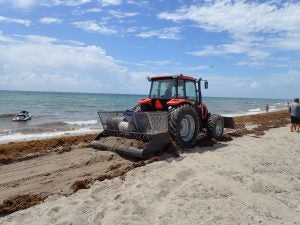NOAA awards $11.6 million for harmful algal bloom research
Projects will help enhance monitoring and determine socioeconomic impacts of blooms
NOAA is announcing funding of 17 new research projects around the country to better understand and predict harmful algal blooms (HABs) and improve our nation’s collective response to them.
NOAA’s National Centers for Coastal Ocean Science (NCCOS) allocated $10.3 million to harmful algal bloom research in fiscal year 2020 for work that will take place over the next three to five years. Approximately $4 million will cover the first year of 11 new projects, while $6.3 million will go to 16 projects already in process. New projects will begin in Alaska, California, Delaware, Florida and the Gulf of Mexico, the Great Lakes, New England, the Pacific Northwest, Puerto Rico and the U.S. Virgin Islands. A full list of the new grant awards is available online.
Award recipients will research enhanced detection of harmful algal bloom toxins and test control methods in both ocean and freshwater; model toxin movement through food webs; improve HAB forecasts; and investigate the social and economic impacts of blooms.
“NOAA is funding the latest scientific research to support managers trying to cope with increasing and recurring toxic algae that continue to affect environmental and human health of coastal communities,” said David Kidwell, NOAA NCCOS Competitive Research Program director. “These projects will address the largely unknown socioeconomic impact of blooms in various regions, improve local managers’ ability to keep drinking water safe, aid monitoring for algal toxins in seafood and advance a potentially valuable control method for Florida red tide and other blooms, enhancing our nation’s collective response to these events.”
Researchers from the University of Rhode Island (URI) and the Woods Hole Oceanographic Institution (WHOI) have teamed up to explore the social, cultural and economic impacts of massive blooms and onshore accumulations of Sargassum in the Caribbean, and the ways that individual residents and communities are responding to these events. As the lead institution for this project URI is receiving $838,138 for this three year project, and subcontracting to WHOI for $160,000.
The interdisciplinary research team includes Dr. Carlos Garcia-Quijano and Dr. Tracey Dalton from the URI Marine Affairs Department, Peter Freeman of the URI Coastal Resources Center, Ken Hamel, a PhD student in Marine Affairs, and Dr. Di Jin from WHOI’s Marine Policy Center. An advisory group of local resource users, scientists, officials and managers will help to guide the project, which will run through 2023.

By Ken Hamel (PhD student, URI Marine Affairs)
This project is expected to contribute new knowledge about the social, cultural, and economic impacts of Sargassum bloom events on Caribbean communities, improved economic cost estimates of HAB events, and improved preparation and response to Sargassum bloom events. In addition, the project will help to identify strategies for reducing vulnerability and increasing resilience of communities affected by Sargassum blooms.
Contact: Tracey Dalton, URI Professor and Department Chair of Marine Affairs, dalton@uri.edu
